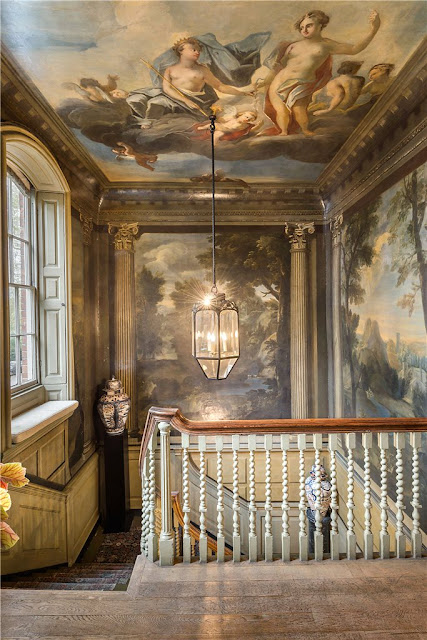Over the weekend, I read a New York Times article about the Cheyne Walk mansion that former New York mayor Michael Bloomberg recently purchased for £16 million pounds (around $25 million.) Wishing to learn more about the house, I clicked through to view the property's real estate listing. Although the London townhouse is better known as the long-ago home of writer George Eliot, I immediately recognized it as the residence of the late Victoria Press, the home's most recent owner who was profiled in T Magazine this Spring. It was the listing photo of the home's drawing room, with its ornate, Blanc de Chine-adorned overmantel, that clued me in.
I have included some of the Strutt & Parker listing photos here, but for the full range plus specifics on the house, please visit the firm's website.















Now there is a house! I love it all, and wouldn't change a thing - but for the Motel 6 bed in the master bedroom. Where did THAT come from? The stair hall looks like one in a scene in Howard's End. Wonder if it is the same?
ReplyDeleteCynthia, It's been so long since I've seen Howard's End that I don't recall that scene. Now I wonder, too.
DeleteIf Cynthia is referring to the double height stair hall of what was meant to be the Wilcox's London house in Howards End, where the Antony Hopkins character proposes to that of Emma Thompson, it wasn't the painted hall of No 4 Cheyne Walk...more likely an Edwardian period house in Kensington or Mayfair?
DeleteFound it:
DeleteThe interior staircase, where Wilcox proposes to Margaret Schlegel after the death of his wife Ruth, is 2 South Audley Street in Mayfair,
Apparently, it's at 2 South Audley Street in Mayfair, so that was a good guess, Toby Worthington.
DeleteWow! Extraordinary detail!
ReplyDeleteWow! is right. :)
DeleteAccording to James Stourton's excellent book Great Houses of London, the house built 1718 remains fairly unchanged.
ReplyDeleteIts chief glory, based on photographs in that book, is undoubtedly the staircase painted circa 1730 in the manner of Sir James Thornhill-- and it had better be preserved, is all I can say! Jamie Drake, take note.
I hope so as well. Surely there must be some kind of protection in place to preserve it??
DeleteThe house is Grade II listed, which means that it is of historical or artistic value and it will not be possible to remove or alter any of the listed features. The painted staircase will have to remain as is. We are quite particular about things like that in England. On the matter of the bedroom, as another reader has commented above, there is a certain tackiness to it. Perhaps it was styled by the estate agents for the listing pictures or, perhaps that private domain represents the personal taste of the previous occupant, as opposed to the other rooms which have clearly been professionally decorated.
DeleteWould love to know more about Victoria Press's life and homes. The NY Times article gave brief hints but I couldn't find more info online.
ReplyDeletePaintbrush, I, too, have tried to research Victoria Press online. There is so little posted about her.
Deletestunning + I work in London, will have to go by. xxpeggybraswelldesign.com
ReplyDeleteDarn. I've been trying to win PowerBall since that home went on the market! No such luck.
ReplyDeleteThe house is Grade II*. 5.5% of listed buildings in England are Grade II*. To make any alterations that would affect the character or appearance of a building of special architectural / historic interest, one must first apply for listed building consent. Many people ignore this and apply for retrospective listed building consent after works have been carried out. We are losing great swathes of historic fabric - people want open spaces and big windows. Georgian, Victorian, Edwardian even houses with Tudor and medieval elements are being lost. The most vulnerable is the c20 period. Our historic environment, especially interiors are in such a vulnerable state. All but a handful of our conservation officers were made redundant due to the financial crisis. I'm an Historic Conservation Researcher. I recently discovered five different types of wallpaper in two different locations. One building dates back to c1330. The other is a former medieval hall house. Major alterations will be occurring in one of them. My role is to photograph and record what will be lost. Until people embrace a building's unique character, they will continue to be open to all sorts of damage. Sorry for such a heavy reply. I'm sure Mr Bloomberg will treasure Cheyne Walk. No one owns an historic property. They are its custodians. It's a privilege too.
ReplyDeleteThere is more about Victoria Press in the 2023 book called 'Creating Coromandel' published by Artifice.
ReplyDelete